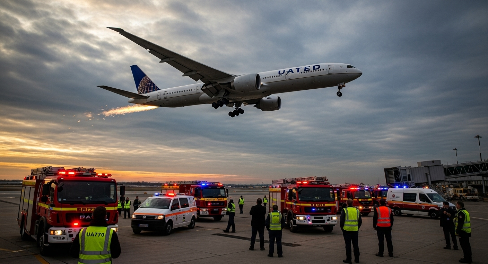When Flight UA770 Took a Safety Detour: Inside United Airlines’ Emergency Diversion
It was May 27, 2025 — a seemingly routine transatlantic flight became a high-stakes test of protocol, coordination, and calm under pressure. United Airlines flight Flight UA770 Emergency Diversion, en route from Barcelona to Chicago, issued a “Squawk 7700”, signaling a general emergency mid-air. Within minutes, the Boeing 787‑9 Dreamliner rerouted to London Heathrow, landing safely at 4:55 PM BST on Runway 27R, before docking at Gate B44 with no injuries reported Facebook+8Travel And Tour World+8The Mystery Magazine+8.
Understanding this incident requires more than a timeline—it requires a deep dive into what happened, why it matters, and what flyers should take away.
Table of Contents
The UA770 Incident: What We Know
UA770 took off from Barcelona’s El Prat Airport bound for Chicago O’Hare. About 1½ hours into the flight, the crew triggered the transponder’s emergency code “7700,” marking a serious situation. ATC swiftly rerouted the flight to London Heathrow, where arrival was smooth, and passengers disembarked without incident The Mystery MagazineBaddiehu+3Travel And Tour World+3The Mystery Magazine+3Baddiehu.
United Airlines confirmed the diversion and noted a one‑hour stopover for aircraft inspections . Despite the alarm a “general emergency” can raise, passengers reported a smooth, orderly landing. UA770 really showed that even amid uncertainty, airline safety systems and personnel can keep everything under control.
Decoding “Squawk 7700” and Emergency Diversions
Reflexive panic aside, Squawk 7700 is a standard, structured alert that signals “urgent attention needed,” not necessarily impending doom. Common causes include mechanical faults, medical emergencies, or environmental hazards. Unlike hijack alerts (7500) or radio loss (7600), 7700 covers a broad range of serious but manageable issues Facebook+8ImperFeed+8Baddiehu+8.
The moment UA770’s pilots dialed in 7700, air traffic control responded with priority clearance, emergency runway preparation, and ground support standing by. It’s a deliberate chain of steps built to keep everyone safe—and it worked exactly as designed in this case.
Why Choose London Heathrow?
The selection of Heathrow as UA770’s emergency landing site wasn’t happenstance. Airports capable of hosting a long-haul widebody aircraft like the 787‑9 require robust infrastructure—and Heathrow checks those boxes:
-
Proximity: Heathrow was the closest well-equipped diversion point on UA770’s flight path.
-
Expert Personnel: With world-class maintenance, fire, rescue, and medical teams, it was ready for anything.
-
Passenger Support: Bonded customs, hotel access, and rebooking systems are crucial mid-flight BaddiehuAIRLIVE+2Travel And Tour World+2The Mystery Magazine+2ImperFeed.
Big airports aren’t just busy; they’re prepared—for exactly this kind of event.
Possible Causes Behind the Diversion
United hasn’t released specifics, but the usual suspects in a general emergency diversion include:
-
Mechanical alerts: Today’s jets are monitoring systems in real time, and even intermediate warnings are taken seriously.
-
Medical issues: A serious passenger health event could prompt an immediate diversion.
-
Sensory concerns: Something like cabin smoke or a sudden system odor might trigger precaution.
In UA770’s case, the absence of pilot control loss or visible smoke suggests a systems alert. The fact that Heathrow admitted the aircraft and let passengers off in an hour implies a resolvable, external concern—highlighting crew professionalism over panic.
Crew Response: Training in Action
UA770’s inflight handling deserves deeper recognition. Modern general-emergency protocol unfolds in four high-priority steps:
-
Assess & confirm using cockpit diagnostics
-
Inform ATC, receive priority routing
-
Communicate with cabin crew, preparing passengers
-
Calculate fuel reserves, ensuring diverted landing holds margin
In UA770’s story, everything unfolded in proper order. There was no visible anxiety, no rushed maneuvers—just practiced calm. Crew and ATC coordination worked flawlessly to land the flight safely at Heathrow.
Passenger Experience & Aftermath
Passengers aboard UA770 described a calm, professional environment. Transparent communication, credit to the cabin crew, and post-landing assistance smoothed what could have been a fraught situation. United arranged alternate flights, accommodations, and vouchers where needed Baddiehu+2ImperFeed+2The Mystery Magazine+2.
Here’s what passengers generally go through during diversions:
-
Cabin preparation and reassurance
-
Deplaning in unexpected locations
-
Unplanned overnight stays or next-day travel changes
-
Rebooking through airline app, kiosk, or staff
It’s a minor disruption—handled with dignity and care by the airline that day.
Safety Takeaways & Industry Impact
UA770’s diversion offers tangible lessons:
-
Minor Systems Alerts Can Trigger Major Protocols: The mere sounding of system alarms or pilot judgment can activate a full emergency diversion.
-
Infrastructure Matters: Big airports like Heathrow aren’t just for convenience—they are hubs of rapid crisis response.
-
Training Saves Lives: Crew performance under pressure reinforces the power of regular drills and calm execution.
-
Data Drives Change: Every diversion feeds future safety improvements through rigorous investigation and policy adjustments The-Baddie Hub+3ImperFeed+3Baddiehu+3en.wikipedia.org+9The Mystery Magazine+9The-Baddie Hub+9Baddiehu+2Travel And Tour World+2Facebook+2Baddiehu.
These incidents fuel progress. For airlines, each case is a reminder to invest in crew training, communication upgrades, and real-time monitoring.
Conclusion: Trust in Safety Systems
United Airlines Flight UA770 wasn’t a headline for tragedy—it was a live demonstration of aviation safety protocols in motion. A technical hiccup triggered a full, well-integrated emergency diversion, and a Boeing 787‑9 landed safely in London with all passengers intact.
For travelers, the message should be clear: these kinds of events exist because they protect us. While sudden and confidential, diversions are airline decisions built on responsibility, not fear. Next time your screen glows with “emergency declared” on a flight tracker, know that it may well be the system at work—keeping you safe.
Frequently Asked Questions
1. How often do airlines declare Squawk 7700?
It’s rare—fewer than 1 in 1,500 flights. Most alerts are mechanical checks or health issues, not full-blown crises The-Baddie Hub+6ImperFeed+6The Mystery Magazine+6Baddiehu.
2. Will a diversion mean I lose my flight?
Not usually. Airlines rebook you on the next flight or offer vouchers. Overnight stays are often covered too.
3. Does squawking 7700 guarantee a crash?
Absolutely not. It’s a precaution. Many diversions end peacefully—as UA770 did—with no damage or risk.
4. What should passengers do when a diversion happens?
Stay calm, follow crew directions, brace as instructed, and reach out for rebooking assistance post-landing.
5. Could the same thing happen to me?
Yes—diversions can happen on any flight. But remember: indicators and systems exist to catch issues early. It’s why the system works.
6. How does this compare to bigger incidents like UA328 in 2021?
UA328 saw an engine failure over Colorado with damage, but still no injuries en.wikipedia.org. UA770 had none of that flair or risk—it was proactive.
Final Thoughts
The story of United Airlines Flight UA770 emergency diversion isn’t one of panic. It’s one of readiness, coordination, and strategic care. The aviation system isn’t built on hope—it’s built on preparation. So if you find yourself tracking a diverted flight in the future, take a moment: this could be another instance of safety steering the way.





Leave a Reply